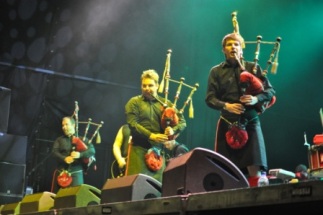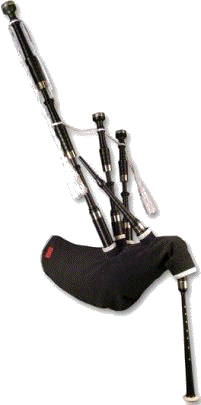
Red Hot Chilli Pipers @ FolkWorld:
FW#39, #42, #43, #44
www.myspace.com | www.youtube.com
www.redhotchillipipers.co.uk
Thomas Zippel of Redpipes electronic pipes met Stuart Cassels und Kevin MacDonald, two of the three bagpipers of the Red Hot Chilli Pipers, during their German tour in Stuttgart and took the occasion to have a short interview with them.

Stuart, Kevin, how is the tour in Germany going?
Kevin: It works out just fine. We only had four gigs to date but tonight the show is again sold out.
Stuart, will you play the redpipe tonight?
Stuart: No, not on this tour. We mostly play our old program cause we do a lot of gigs at venues where we haven’t been before. But with the new CD we used the redpipe for a couple of songs and on our next tour we will also use it on stage because otherwise we couldn’t do these songs properly.
Stuart, what was your personal motivation to get you an electronic bagpipe?
Stuart: Well, mainly because of tuning issues. If you play at locations with extreme changes of temperature you need a bagpipe that keeps the tuning constantly. Furthermore because of the new possibilities that you have with the redpipe such as different keys for example. Or we can back the real bagpipes with the redpipe so they can come in one octave higher. With the Great Highland Bagpipe we are somewhat restricted with the range of notes we can play and we can complement this very good with the redpipe.

What’s the main difference with using the redpipe in the studio?
Kevin: Time. With our normal bagpipes we only have a certain amount of time to record
before the tuning has to be adjusted again. Especially when you play complex tunes with four
or five harmony parts which you want to play simultaneously with more than one bagpipe it
takes a lot of time cause often you must tune again even for single notes. So with the redpipe
it is a lot easier to work in studio.
But it’s more tricky to integrate the redpipe on stage because the other bagpipes will change
their tuning slightly while the redpipe always stays constant. We have to work on that with the
band. At locations like this here in Stuttgart it’s no big problem because the temperature
doesn’t change a lot during the evening. But we often play open air gigs with big changes in
temperature and the normal bagpipes do react on this.
Do you also use the extended mode, I mean the possibility to use more half-notes with the bagpipe?
Stuart: Sure and this provides additional options for the band. On our next album we will work with different keys, so we can play songs which we couldn’t play hitherto and have more variability.
You also give bagpipe-lessons on schools all over the world. What do you think about the redpipe as a learning tool?
Kevin: Well the core training should be done on a real Great Highland Bagpipe if you want to become a real bagpiper. But with the redpipe you can practise with low volume or with a headset and further it helps if the muscles in your mouth that you need for blowing are not yet developed. You can practise longer by adjusting the amount of air so you can also play with little blowing. In so far the redpipe can assist the process of learning the GHB – though it’s no substitution for the real thing.
Stuart you recently started a campaign to get more young people to play bagpipe. Is an instrument like the redpipe helpful for recruiting new bagpipers?
Stuart: Of course we want the offspring not to give up on learning the GHB. But on their way
to that it might be quite helpful if you can practise without making your neighbour your
enemy. Even in Scotland people are not always tolerant when it comes to hours and hours of
bagpipe-practise in the room next to you.
Further the electronic bagpipe provides new opportunities for young musicians concerning
playing in a band or using the bagpipe for different styles of music. You can play over a Wha-
Wha-pedal for example which is not possible with a miked bagpipe as the signal will be too
weak.
Photo Credits: (1) Red Hot Chilli Pipers, (by Adolf „gorhand“ Goriup); (2) Redpipe 'Caledonia' (from website).